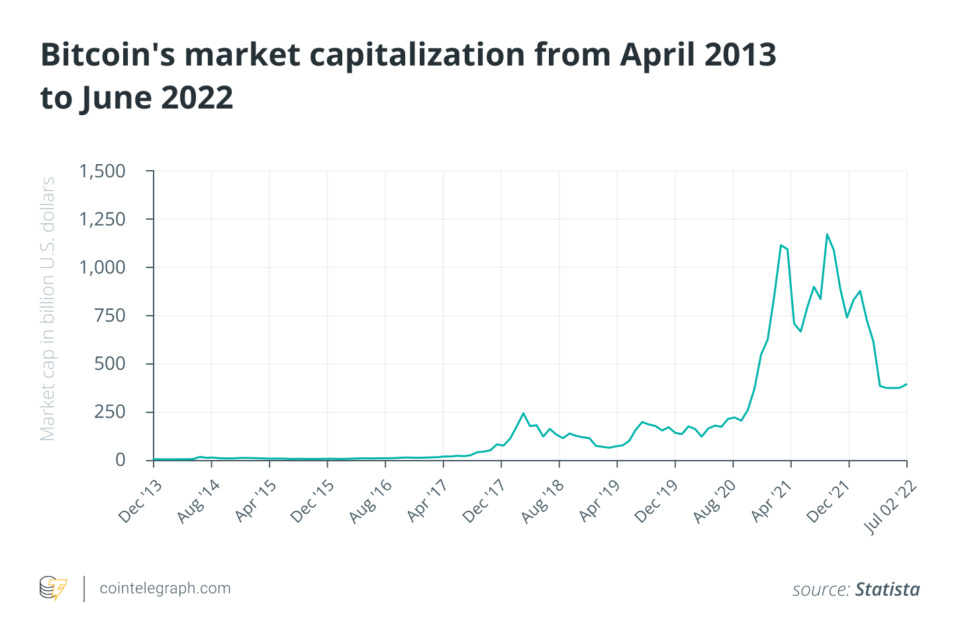By the end of May, Bitcoin’s (BTC) price had dropped 40%, Ether (ETH) had lost 50% of its value, and the entire crypto market dipped below its $1-trillion capitalization for the first time since January 2021. As we enter a clear bear market trend, it’s essential to focus on what the blockchain industry has always suggested : build.
Bitcoin, Ether and the broader crypto market’s downturn correlate to macroeconomic uncertainty. The uncertainty is driven by rising interest rates coupled with quantitative tightening, resulting in asset price sell-offs across the stock exchange and the crypto market. It’s entirely possible that we can see the repeat of events like the Terra ecosystem’s unwinding, crypto lending service Celsius’ fallout, and the hedge fund Three Arrows Capital’s $400-million liquidation losses.
2022’s market crash to 2018’s crypto winter
The 2018 crypto winter was brought about by negative market sentiment and loss of confidence; however, 2022’s crypto winter is a direct result of macroeconomics. Decentralized finance (DeFi) is down, equities are down and global markets are down. This bear market is not isolated to crypto alone, with leverage unwind simultaneously occurring across several markets.
Venture capitalists and private investors pumped no less than $30 billion into blockchain projects. A third of that amount went to gaming and virtual world projects to lay the foundations of the Web3 metaverse.
As we witness an exodus of talent from Web2 projects, we also anticipate increased growth of Web3 brands, with several brands such as Yuga Labs, The Sandbox and RTFKT already partnering with retail giants, including Adidas, Nike, HSBC, Warner Bros and others. Blockchain-powered decentralized applications (DApp) and DeFi have the potential to lead the Web3 evolution in the future and seize control from a handful of centralized gatekeepers.
This indicates that the transition to Web3 is imminent and dependent on a catalyst to proliferate. A crypto winter can undoubtedly be considered a significant catalyst, as it affords Web3 projects downtime, whereby they can focus on scalability and sustainability.
Related: Hiring top crypto talent can be difficult, but it doesn’t have to be
Crypto winter is not a time to hibernate, but to continue building
During the 2018 crypto winter, we saw a notable rise in several disruptive projects, such as OpenSea and Uniswap. Despite the downward trend, the projects leading the blockchain space were committed to building and enhancing their products.
These projects took years to be successful. In 2021, OpenSea generated $20 billion in nonfungible token (NFT) sales, while Uniswap adoption grew significantly, showingcasing the potential of a decentralized financial system. Other examples in DApps, DeFi, NFTs and Web3 games are abundant.

The key to expanding the Web3 community is utility
During the current crypto winter, there’s likely to be more venture capital available to fund new projects, so they may not only survive but thrive during the next big surge. And that’s the key to survival — utility. Projects that offer utility succeed, while those that are fundamentally flawed, over-hyped and non-utilitarian end up failing. A crypto winter, therefore, separates the proverbial wheat from the chaff.
One of the best ways for crypto projects, whether DeFi, GameFi or NFT-related, to transition from Web2 to Web3 is to consider the implication of housing processes on-chain. Not only that but accelerating business growth through cost-cutting is essential. Payment gateways charging inflated fees should be the first to be scrutinized, and it certainly makes sense to consider a viable approach to the intrinsic practice of turning a profit.
Related: Governments, enterprise, gaming: Who will drive the next crypto bull run?
Crypto payment solutions that allow crypto on- and off-ramps are helping Web3 firms accelerate their business as the solution enables transactions to happen off-chain, which makes the fees involved dramatically cheaper than standard payment methods. It also facilitates improved conversions and revenue by enabling a project’s users to buy and sell crypto at competitive rates within the project’s platform. Crypto platforms looking to streamline their payment infrastructure should consider fully integrated on- and off-ramps.
The demand for API solutions like on-and-off-ramp platforms is constantly growing because they help businesses to settle different currency and cryptocurrency transactions, reducing the counterparty risk and costs, thereby empowering businesses and their users. Such platforms also offer price transparency with leading exchange rates with low conversion spreads, so users know what they’re going to pay and what they’re paying for.
In this ensuing winter, this is the type of opportunity that we should seek: projects that are ground-breaking and scalable infrastructure that will drive the next evolution of the digital asset ecosystem. As always, the key to knowing when to be greedy when others are fearful, and fearful when others are greedy isn’t as simple as it would sound, but business platforms built upon solid foundations stay reliable in the long run and have a built- in resilience that will see them through good times and bad, such as the crypto winter we’re going through.
This article does not contain investment advice or recommendations. Every investment and trading move involves risk, and readers should conduct their own research when making a decision.
The views, thoughts and opinions expressed here are the author’s alone and do not necessarily reflect or represent the views and opinions of Cointelegraph.
Raymond Hsu is a co-founder and the CEO of Cabital, a cryptocurrency wealth management platform. Prior to co-founding Cabital in 2020, Raymond worked for fintech and traditional banking institutions, including Citibank, Standard Chartered, eBay and Airwallex.
